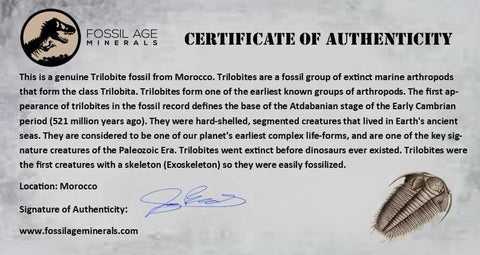3.5" Crotalocephalus Gibbus Trilobite Fossil Morocco Devonian Age 400 Mil Yrs Old COA
Location: Lghaft, Morocco
Weight 11.3 Ounces
Dimensions: 3.9 Inches Tall, 2.2 Inches Wide, 1.9 Inches Thick (Matrix)
Trilobite Dimensions: 3.5 Inches Long, 1.2 Inches Wide, 0.6 Inches Thick (Head To Tail)
Comes with a Certificate of Authenticity.
The item pictured is the one you will receive.
Crotalocephalu
Trilobites are a group of extinct marine arthropods that are classified in the class Trilobita. They are among the earliest known arthropods. The appearance of trilobites in the fossil record marks the beginning of the Atdabanian stage of the Early Cambrian period, about 521 million years ago. These creatures had hard shells and segmented bodies, and they lived in Earth's ancient seas. They are considered some of the earliest complex life-forms on our planet and are key indicators of the Paleozoic Era. Trilobites went extinct before the era of dinosaurs.
Trilobites were the first creatures with a skeleton (Exoskeleton), so they were easily fossilized. Their shell is divided lengthwise into three lobes (hence, the name TRILOBITE meaning "three-lobed"): a central axial lobe, and two symmetrical pleural lobes that flank the axis.
Morphologically, the trilobite body is divided into three major sections:
1. a cephalon (or head) with eyes, mouthparts, and sensory organs such as antennae.
2. a middle region called the thorax with several overlapping segments (anywhere from 2 to 61).
3. a pygidium (or tail section) in which the segments were fused.

Please be aware of the nature of fossils:
Being buried under the ground for millions of years under tons of pressure tends to be rough. No fossil comes out of the ground whole and perfect. Most fossils have undergone some restoration, while others are altered by man simply to enhance their presentation in different ways. The workers in Morocco do a very professional job, of unearthing and preserving these natural treasures, however, commonly natural cracks are visible on the surface. These are part of the natural beauty of the fossil and are not considered defects.



















